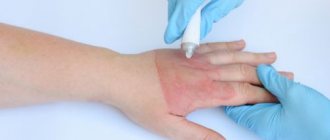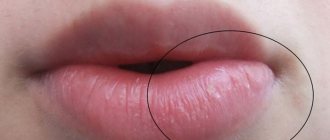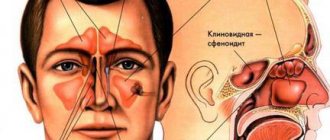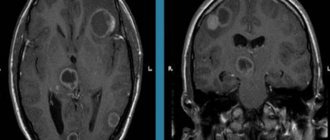1.General information
Erysipelas, erysipelas - these and similar terms are used mainly in Slavic languages; in medical Latin and most Western European languages, the original ancient Greek name erysipelas was fixed, i.e. "red skin" In the old days there were also synonyms “holy fire”, “Saint Anthony’s fire” or, in Russian, “Antonov’s fire”, although some dictionaries define this term as one of the designations for gangrene.
Erysipelas is an acute skin infection (or recurrent exacerbation of a chronic one), the hallmarks of which are swelling and erythema - a bright red, “fiery” hue of the affected area. In general, erysipelas is one of the most common human infectious diseases; the localization of inflammation can be very different, however, due to the peculiarities of the anatomical structure, the disease often manifests itself on the skin of the face, primarily in the soft tissues of the external nose (vestibule, wings, nasal walls): a high concentration of sebaceous glands, capillaries and nerve endings facilitates the penetration and activation of the pathogen .
A must read! Help with treatment and hospitalization!
Treatment of cancer of the nasal cavity and paranasal sinuses
Surgery
The extent of surgical intervention depends on the extent of the tumor process and may consist not only of removing the tumor within healthy tissue, but also excision of lymph nodes in the neck.
The anatomy of the nasal cavity and paranasal sinuses is very complex because the most important nerves, blood vessels and other structures are located near this area.
The proximity of the brain, eyes, mouth and carotid arteries, which provide nutrition to the brain, greatly complicates the performance of operations.
In this case, it is necessary to take into account the appearance of the face and the subsequent ability to breathe, speak, chew and swallow.
Unfortunately, in some cases, by the time of diagnosis, the tumor may have spread to the orbital area. In this situation, during surgery, not only the main tumor is removed, but also the eye and orbital tissue.
For nasal cavity cancer, a wide excision of the lesion within healthy tissue is performed.
This may require partial or complete removal of the nasal septum. If the outer part of the nose is affected, it may be necessary to partially or even completely remove the nose and then reconstruct it from the surrounding tissue. In addition, there are now cosmetic prosthetic noses made from artificial materials.
For tumors of the paranasal sinuses, extended surgical interventions are possible with the removal of bone tissue of the face, jaw, and orbit.
Endoscopic operations are performed using special telescopic instruments for small tumors or for palliative purposes, when the patient for some reason cannot undergo complex extended surgery. Typically, such operations are combined with subsequent radiation therapy.
Cancer of the nasal cavity and paranasal sinuses sometimes metastasizes to nearby lymph nodes.
For this reason, depending on the extent of the process, removal of several or all affected lymph nodes is performed.
In patients with cancer of the nasal cavity and paranasal sinuses, radiation therapy can be used either as an independent method or as an addition to surgery.
Radiation therapy as an independent method may be recommended for patients with small tumors. In this case, a complete cure is possible while maintaining good cosmetic results.
Radiation may be used in patients with poor general condition who cannot undergo complex surgery.
If the main tumor is not completely removed, radiation therapy is prescribed to destroy the remaining tumor cells. Radiation can be effective if used for palliative purposes to stop pain, bleeding, improve swallowing function, and also for cancer metastases to the brain.
Temporary side effects of radiation therapy include skin damage, loss of appetite, decreased taste, sore throat, hoarseness, difficulty swallowing, and increased fatigue.
These phenomena resolve on their own soon after cessation of irradiation.
Radiation therapy can cause blurred vision, dry mouth due to damage to the salivary glands, bone damage, and dysfunction of the thyroid gland.
The most commonly used antitumor drugs in patients with cancer of the nasal cavity and paranasal sinuses are: 5-fluorouracil, bleomycin, cyclophosphamide, vinblastine and methotrexate.
The drugs can be used individually or in combination.
Chemotherapy kills tumor cells, but can also damage normal cells, leading to side effects and complications, including nausea, vomiting, loss of appetite, baldness, mouth ulcers, increased susceptibility to infection, and bleeding.
After stopping treatment, most side effects go away.
2. Reasons
Erysipelas is a bacterial infection, the causative agent of which is almost always group A beta-hemolytic streptococci. This tendency, however, is not absolute: a similar inflammation can be caused by staphylococcus, especially in cases of a long-term chronically recurrent process, as well as other pathogens. In general, we have to take into account the fact that in recent decades in the clinic of infectious diseases, incl. skin, there is a steady tendency towards an increase in combined invasions (for example, bacterial and fungal), developing according to the mechanism of super- or coinfection.
The main risk factor is microtraumatization of the skin of the nose in combination with weakened local immunity and non-compliance with sanitary and hygienic rules.
The risk increases in the presence of foci of chronic coccal infection in adjacent tissues and organs (otitis, tonsillitis, sinusitis, and many others). One of the widespread causes of erysipelas is the practice of self-squeezing out elements of acne and/or pustular (pustular) rash in unsterile or frankly unsanitary conditions. In some cases, nasal erysipelas is iatrogenic in nature, i.e. the launch of the pathological process is caused by medical procedures or surgical intervention on the ENT organs.
Visit our Otolaryngology (ENT) page
What happens after treatment is completed?
After cessation of special treatment, the patient should be under the supervision of doctors and periodically undergo examinations in order to identify and treat complications, as well as early diagnosis of a possible relapse (return) of the disease.
If you smoked and/or drank alcohol, you need to quit these bad habits. This will help improve your condition faster and contribute to a speedy recovery.
If necessary, a nutritionist will help you choose the right diet, taking into account the surgery, radiation and chemotherapy you have undergone, and doctors of other specialties will do everything possible to restore your lost functions of speech, swallowing, chewing, etc.
3. Symptoms and diagnosis
As shown above, typical manifestations of erysipelas of the nose include erythema and inflammatory swelling of the soft tissues, clearly demarcated by a roller from healthy skin. The swelling can be so severe that the patient’s face becomes deformed and changes beyond recognition. Blisters filled with mucopurulent exudate (bullous form of erysipelas) are often observed.
As a rule, the general symptoms of infectious intoxication are pronounced: malaise, fever, hyperthermia (up to 40° and above), headache, weakness, soreness and swelling of the nearest lymph nodes. After a few days, body temperature may drop just as sharply.
It should be noted that in the absence of timely adequate therapy, erysipelas tends to expand to neighboring areas (skin of the face, neck, chest, ear, etc.); with the involvement of the mucous membranes and submucosal layers of the pharyngeal structures, the development of such serious complications as abscess formation, phlegmon, sepsis, and intracranial inflammation is possible.
The clinical picture of erysipelas is quite specific and usually does not create any difficulties in diagnosis. Examination of the ENT organs reveals hyperemia of the mucous membranes of the nasal cavity. Laboratory diagnostic methods are used to identify the pathogen(s) and assess drug sensitivity. In more complex cases, they resort to instrumental imaging diagnostics (endoscopy, ultrasound, etc.).
About our clinic Chistye Prudy metro station Medintercom page!
Combined drug Vibrocil for nasal congestion
The medicine contains antiallergic substances dimethindene and phenylephrine. The first, when applied topically, inhibits the activity of histamine receptors; Phenylephrine has a vasoconstrictor effect. Vibrocil is produced in the form of nasal gel, spray and drops.
Drops are used for allergic rhinitis, ARVI and colds in children over 12 months.
How to remove nasal congestion in a child using Vibrocil:
- For children aged 1 to 6 years, instill the product three times a day, 1-2 drops into each nasal passage.
- If your child has nasal congestion at night and swelling of the bridge of the nose, use nasal gel.
- To treat a child over 6 years old, you can use Vibrocil drops, spray or gel.
- Immediately before using the product, clear the nasal passages of accumulated mucus.
The drug does not have a hypnotic effect. Experts recommend using Vibrocil for no longer than 1–2 weeks. You cannot, at your own discretion, change the dosages indicated by the doctor and listed in the instructions for the medicine.
Symptoms of cancer when you need to see a doctor
There are quite a few symptoms that indicate that a person has cancer of the nose and paranasal sinuses:
- the nose is clogged for quite a long time;
- he feels pain in the area under and above the eyes;
- there is obstruction of the nasal passage on one side;
- The nose often bleeds. This symptom of paranasal sinus cancer should immediately alert you;
- there is purulent discharge that appears from the passages of the nose. This sign of nasal cancer already hints at the disease and you need to go to the doctor with this;
- the sense of smell decreases;
- pain may appear in the facial area, it may also become numb;
- teeth are loose;
- the palate, nose, face become swollen. These symptoms of nasal cancer are known and immediately noticeable;
- Tears flow all the time;
- note such a sign of nasal cancer as blurred vision, bulging eyes on one side;
- it is difficult to open your mouth, there are some difficulties;
- The lymph nodes in the neck area become enlarged.
The above symptoms of cancer of the nose and paranasal sinuses should attract attention and force you to contact a cancer oncologist in the Central District.
Risk factors
Of course, there are categories of people who are more prone to developing cancer of the nose and paranasal sinuses. These include those who:
- smokes Sinus cancer often occurs in smokers, because they regularly put their health at risk;
- works with flour dust and wood for a long period of time. Participation in the manufacture of leather goods and textile products also contributes to the development of malignant tumors;
- comes into contact with radium, isopropyl alcohol, dust (chrome, nickel), solvents that are used for the production of shoes and furniture, formaldehyde, and glue. These causes of nasal cancer are the most common;
- has sinusitis, rhinitis in the chronic stage;
- abuses alcoholic beverages;
- lives in places where there is an unfavorable environment;
- who has been diagnosed with papilloma virus, it can serve as a sign of nasal cancer.
Prevention
There are certain precautions that will prevent cancer of the nose and sinuses:
- treat chronic inflammation, as well as benign neoplasms that have arisen in the nose;
- when working in industries that can cause harm to health, use means that provide personal protection;
- give up all habits that are harmful;
- Consult a doctor promptly if you notice symptoms of sinus cancer.










